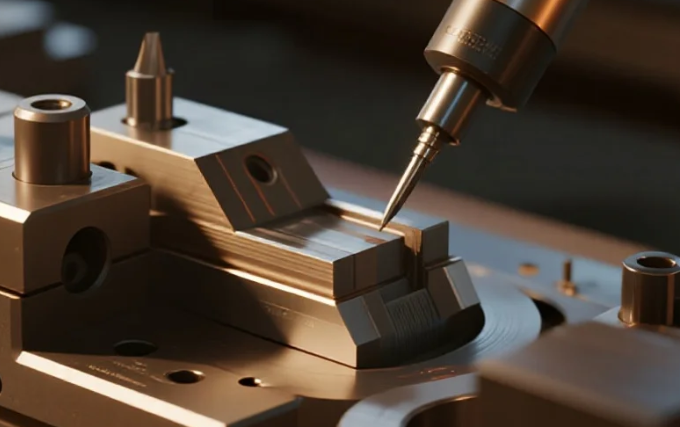Come scegliere una sonda o un laser per l'impostazione e l'ispezione degli utensili durante il ciclo
Il lieve ronzio della macchina CNC riempie il tuo laboratorio — un suono costante che indica che la produzione è in corso, fino a quando non lo è più.
Quell'arresto improvviso quando un utensile si rompe, un taglio è troppo profondo o un pezzo viene scartato. Materiale sprecato. Ordini ritardati. Tutti abbiamo provato questa frustrazione.
Ma cosa succederebbe se potessi prevenire questi guasti prima che accadano?
È qui che regolazione e ispezione degli utensili durante il ciclo entrano in gioco i sistemi. Questi dispositivi, siano essi sonde o laser, vengono montati direttamente all'interno della tua macchina per misurare automaticamente utensili e pezzi mentre la CNC è in funzione.
La vera domanda diventa:
Quale fa al caso tuo?
Sonda o Laser: Qual è la Differenza?
Confrontiamoli.
A sonda a contatto funziona come un pulsante estremamente preciso — quando la punta dell'utensile la tocca, genera un segnale. È ideale per l'allineamento dei pezzi, la verifica delle attrezzature e il controllo della lunghezza degli utensili.
? Esempio: Dopo aver caricato un nuovo pezzo, la sonda verifica che sia posizionato correttamente, evitando lavorazioni non allineate.
A sistema di impostazione utensili laser , d'altro canto, utilizza un fascio laser senza contatto per scansionare gli utensili mentre ruotano. Rileva l'usura degli utensili, le variazioni del diametro e persino le scheggiature minime.
⚙️ Esempio: Un laser nota che una fresa a tazza si è consumata di soli 0,005 mm e regola automaticamente gli offset, mantenendo costante la qualità del pezzo.
Quale delle due hai bisogno: misurazione a contatto o scansione senza contatto?
Fattori Chiave di Decisione
La tua scelta dipende da tre fattori principali: ciò che devi misurare, l'ambiente del tuo laboratorio e il tuo budget.
Sonde sono robusti, economici ed eccellenti per l'impostazione dei pezzi e i controlli di base degli utensili. Tuttavia, non possono misurare utensili rotanti e le schegge o il refrigerante potrebbero interferire.
Laser offrono un'elevata precisione sugli utensili rotanti e funzionano bene in ambienti sporchi, ma comportano costi più elevati e una configurazione più complessa.
Abbiamo imparato questa lezione in modo molto difficile:
Un giorno, abbiamo installato un sistema laser in un laboratorio con forti escursioni termiche quotidiane. L'espansione termica comprometteva continuamente la calibrazione.
Abbiamo alla fine stabilizzato il sistema con controlli ambientali, ma non prima di alcuni costosi intoppi.
La lezione? L'alta tecnologia funziona soltanto in un ambiente compatibile.
Cosa Dovresti Fare Adesso?
Non acquistare semplicemente l'ultimo gadget. Parti dalle tue esigenze.
Fai un giro nel tuo laboratorio. Osserva i problemi ricorrenti:
-
Gli utensili si rompono spesso?
-
I pezzi finiti sono fuori specifica?
-
Il fermo macchina sta compromettendo la tua efficienza?
Abbinare la tecnologia ai tuoi problemi.
Una sonda potrebbe essere tutto ciò che ti serve per controlli di base.
Per produzioni ad alto mix e alta tolleranza, un laser potrebbe valere l'investimento.



